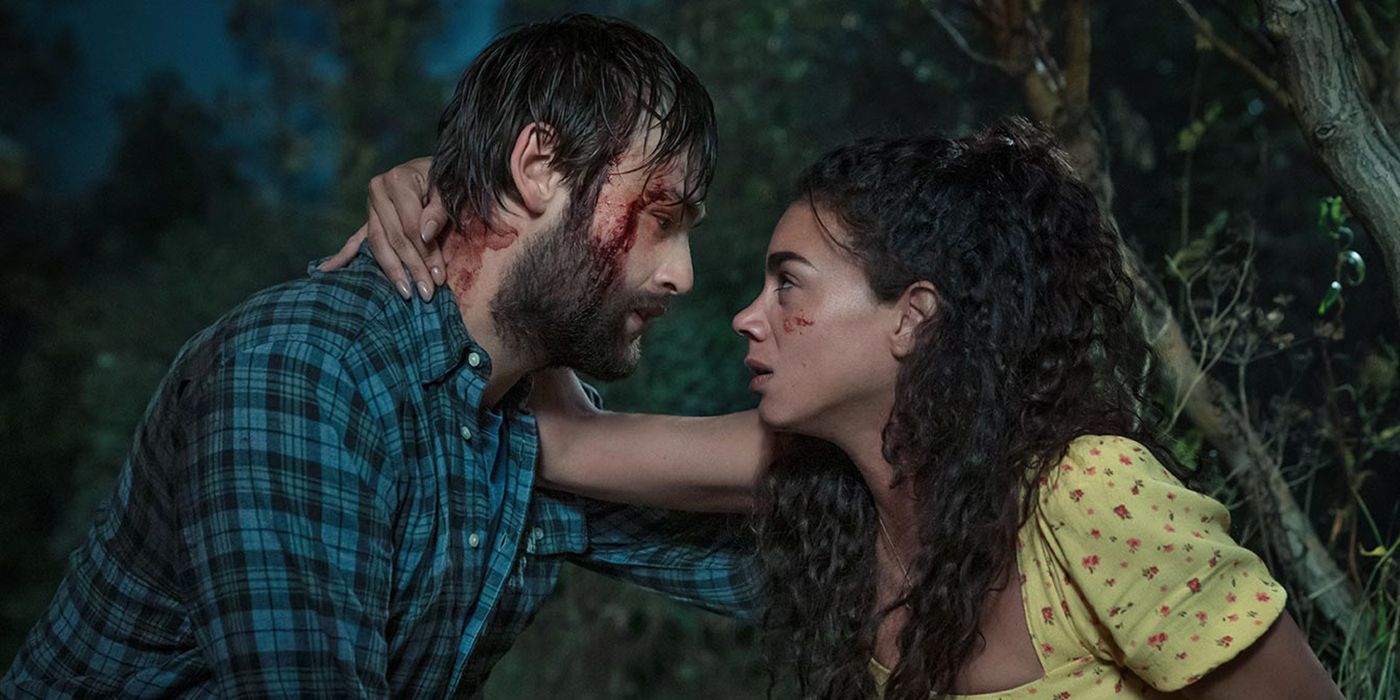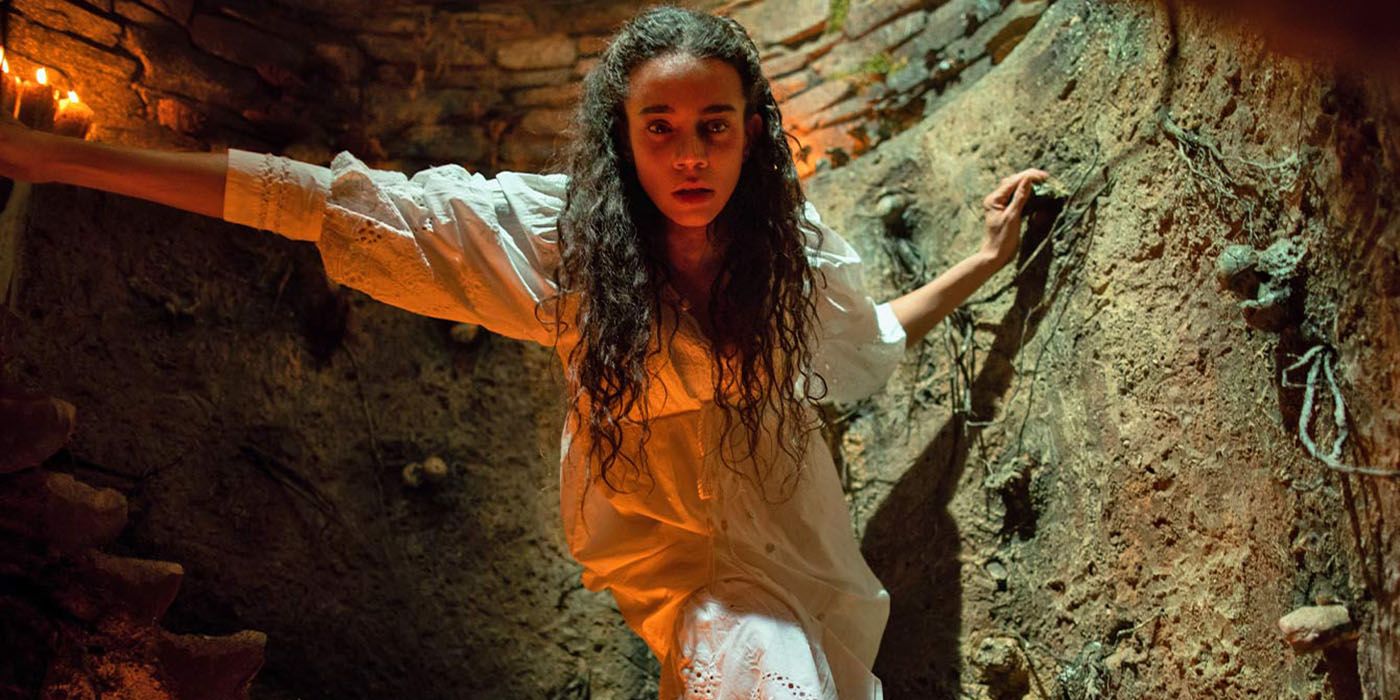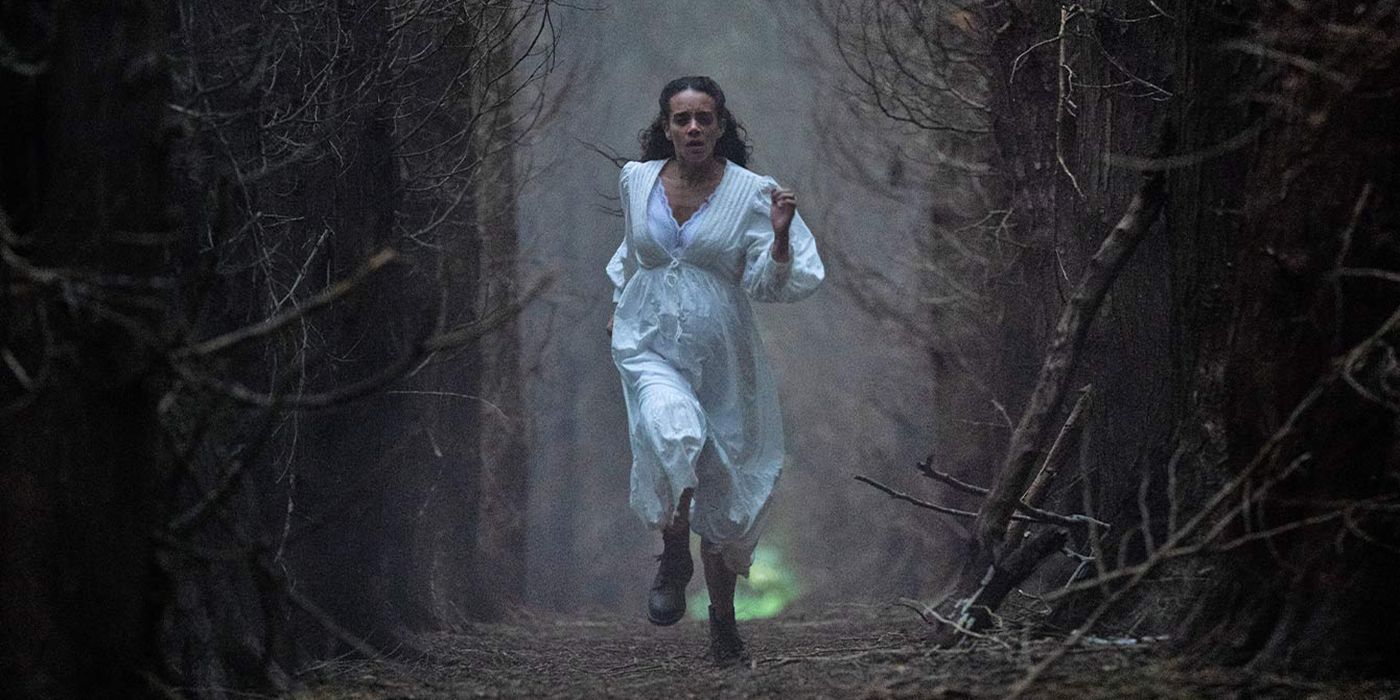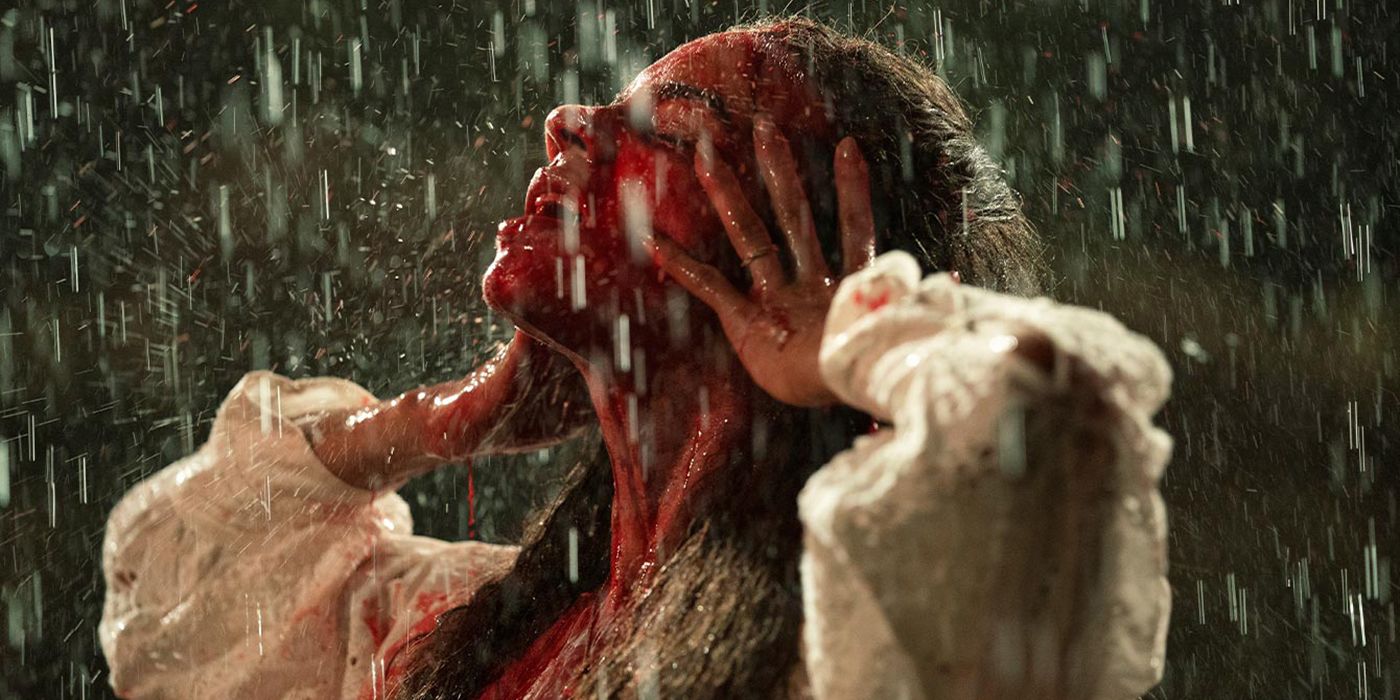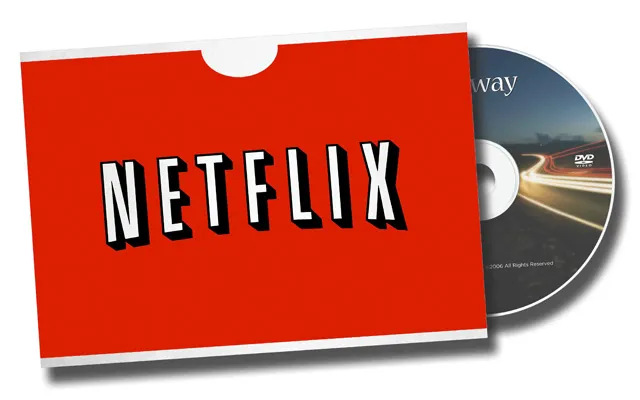[ad_1]
The folk horror genre is getting a fantasy twist with Unwelcome. The film centers on British couple Jamie and Maya who, after being attacked in a home invasion, inherit a house in rural Ireland. But as they prepare for Maya to give birth, they find themselves the target of nasty locals and an ancient force living in the nearby woods.
Hannah John-Kamen and Douglas Booth lead the cast of Unwelcome alongside Colm Meaney, Jamie-Lee O’Donnell, Kristian Naim, Niamh Cusack, and Rick Warden. Blending the best elements of a folk horror fever dream and ’80s creature features, Unwelcome proves to be a throwback gem.
In honor of the film’s release, Screen Rant spoke exclusively with co-writer and director Jon Wright and star Douglas Booth to discuss Unwelcome, the modern horror genre scene, the joys of partnering with Hannah John-Kamen, and more.
Jon Wright & Douglas Booth Talk Unwelcome
Screen Rant: Unwelcome was a treat; it was a bizarre twist on the home invasion genre. Jon, what about the project attracted you?
Jon Wright: Well, I suppose I’ve been seeing a lot of the recent wave of horror films from people like Ari Aster and Jordan Peele, and I was just starting to get excited about horror again. I suppose for me, the point where I was least in love with the horror genre was around the kind of Hostel, Saw time and I was starting to think maybe horror is not really my bag anymore, which was a big statement for me.
The recent wave of the films that are definitely horror movies, there’s no question about it, and they deliver everything that you expect of the genre, so you have the thrills and spills and the blood and guts and the scares and all the things that we know are part of a horror movie, but at the same time, they had very believable performances, they had something to say about modern life, something interesting to say about how we live, about society, about what it is to be alive in the 21st century. I just thought these are good movies and I really started getting the itch to make another one.
I definitely enjoyed seeing a move away from the Saw and Hostel-type films in recent years. Douglas, what about the script and the project spoke to you?
Douglas Booth: I just really loved the script. Everything that this film builds to be was on the page, and it was very well drawn. I thought the characters were interesting, I liked that they had a very strong female at the center of it. I kind of chuckled to myself figuring out how I was going to play this completely useless guy, a guy that you still need to sort of feel for and go with and believe in, and the audience needs to go with you on that journey.
I thought it was an interesting challenge, and I’d also never made a horror movie. I just thought it sounded fun when the Redcaps just started tearing the s–t out of everything, I was like, “This is great.” And I found it very funny, it made me laugh, I thought it had a very interesting sense of humor that I hadn’t — I’m not a huge horror watcher, but it felt original to me. I hadn’t seen anything like it at all. And I had conversations with John, and we got on, and I liked his work, and we we went to work.
Jon Wright: I think what Doug did, which I’m extremely proud of and grateful to him for, is the character Jamie is a coward. I don’t think it’s an insult to the character to say that, because I would say the same thing about myself and my co-writer, Mark Stay, that’s how the film was born. But Doug really played it honestly, what it is to be frightened and what it is to be scared, and what it is to be overwhelmed by fear in a situation where your life is threatened. I think a lot of actors wouldn’t have done that, it takes perversity, ironically it takes a hell of a lot of courage to play a coward, and then Doug did that.
He did it honestly and truthfully. I was really expecting on the day that we shot certain scenes that he would come to me and say, “Look, what if I throw a punch, what if I do this? What if I did something a little bit more heroic? What if he doesn’t quite come at me in the way he does?” Just start to twist it a little bit and just build back in a bit of ego into it, and he didn’t want to do that at all. He was very much like, “Let’s go, let’s go to the heart of this, and let’s really show people what this is like.” I think his character is really interesting and different as a result of that.
Douglas, what you felt were some of the biggest keys in helping balance this weaker character with someone likeable enough for the audience to relate to?
Douglas Booth: Yeah, as John just said, it was about remaining honest. It wasn’t playing it, I wasn’t playing a coward, it was truly trying to examine what I could potentially be like in that situation. We all sit there and think, “What would I do if this happened? I’d be the one that rescues the person.” We don’t know, so I explored the parts of my brain that went to that place of fear and anxiety while trying to do your best, and he does his best, he doesn’t just roll over, he fights as much as he can.
But at key times, it’s her that stands up and is his great protector. I have that in my relationship now, my fiance and are in this amazing relationship, I believe that she’s got my back as much as I have her back, and it’s an amazing feeling. I don’t think that’s portrayed as much in film, I love that she was the alpha in that relationship.
I did love that dynamic between them, and what better way to bring that dynamic to life than Hannah John-Kamen, who has just been incredible in everything. Jon, what was it like searching for the perfect person to pair alongside Douglas for this role?
Jon Wright: Well, I think we’re very lucky to get Hannah, same thing with Doug. I think she just really responded to the script and saw the potential in the film. I knew she was a good actress before I worked with her, obviously, that’s why we cast her and I was very much looking forward to working with her. But I guess what I saw when I worked with her on set is how she really is the real thing, she’s the real deal. I thought, “Okay, this is the star of tomorrow.”
I think that’s already started to be proven, but she’s really that special and she, every day, would do something on set that would surprise me or blow me away. Just the way that she committed to a film that, on paper, is a hokey Creature Feature. There’s definitely a version of this movie, which I don’t think we’ve made, which is a bit goofy and a bit shocking. We tried to make an A-movie out of a B-movie subject matter, and Hannah really is part of that, and Doug as well.
Douglas Booth: She’s also really nice, she’s just a really nice person. She’s really easygoing, she’s got little ego, and we worked very effortlessly together instantly. We didn’t have a huge amount of time to spend together before, but on set, we were just a great team, and Jon was a very sensitive director that I think brought up the best of us.
Jon, you mentioned the schlocky version of this that could have existed. What was it like walking that fine line to make sure you were hitting the higher ambitions that you had with this unique concept?
Jon Wright: Yeah, I like creature features, and I like gory films and violent movies, and I like films that have far-fetched concepts, but I like them to be played straight, and I like them to be done for real. So, I guess that’s the tightrope we have to walk, and I suppose there’s two other versions of the film on either side that we could have been seduced by. So, you could have been kind of drawn into the more goofy, comical elements of the goblins, and there’s things that they could have done that would be tempting that would kind of bump you out of the reality of the film.
Equally over here with the thing that happens to Jamie and Maya, Doug and Hannah, there’s a version of that which is quite dark and morbid, and maybe even bleak and a tiny bit depressing, almost like a gritty real version of that story. I didn’t want to go there either, that was really important to me that the film is entertaining, and that you’re on a bit of a roller coaster, and it takes a it takes a while to get up to the top. There’s a lot of things to enjoy on the way up, but once it gets to the top, you really do drop and I think it’s quite an intense final third, very intense, really.
Did you look towards any specific films for inspiration, be it for the tone or for the creation of the goblins?
Jon Wright: Yeah, Gremlins is a big influence on this movie. There’s another film, I don’t know if you remember, called Cat’s Eye, which is a Stephen King film, the final installment of that with Drew Barrymore, in which she has a little goblin break into her bedroom and steal her breath. That always stayed with me, and the thing I love about that film is they built giant sets for that goblin. So, he comes out and he comes through a hole in the skirting board, and they basically just built a big skirting board. They had a shorter actor, he was a full-grown adult and he had a costume on, and he comes out of a skirting board, and gets on a roller skate, I think, and he maybe gets in a fish bowl or something like that.
All these things were giant, so that’s the way we did our goblins, as well, we built double-high sets. So, that goblin who comes into Jamie and Maya’s house, and he reaches up to the French windows at the back of her living room, those doors are 12 feet high, as opposed to six feet high. He really is reaching up, and that’s a stunt performer in a costume, but he’s wearing a mask sculpted by our brilliant creature designer called Shaune Harrison, and it’s a static mask. One of the things that I didn’t really like about some of those old ’80s creature features is when you get into those close ups — and this is true of Gremlins, which is a film I love and it’s a big influence on this — the faces are a bit static and a bit rubbery, and when they blink, the eyelids don’t really move quickly enough, and they don’t really look very real.
So, we had an actor named Rick Warden, who’s an old school friend of mine from years back, he played the faces and the voices of the goblins. We motion captured his face, recorded his performance, you do loads and loads of different takes, different ways, different improvises, and all kinds of things. Then, that was animated back over the mask, so we photographed the goblin masks, and then the CG guys use that as a very specific reference. That’s how it’s supposed to look, and then they did an animated version of the mask and they tracked it back over the mask. So, I think you’ve got a kind of very interesting marriage of two very old fashioned and very new techniques, and for me, it gives you a really great effect where they look like, when they’re fighting and when they’re walking and interacting, they’ve got gravity, that they’ve got weight.
I think sometimes in modern movies, CG creatures, which often are amazing, sometimes in the wild, you kind of see that they don’t really have the right gravity, and they’re kind of bouncing around and just something instinctively tells you that they’re not really there. But I think with this, you can see that they’re really there. A lot of people have struggled to break down how we’ve done them and they think, “Oh, they’re puppets, they’re just very sort of sophisticated puppets.” There’s a lot of talk about, Jim Henson and things like that, which to me is a compliment.
It’s an effect on the level of Jim Henson Creature Shop, only real, so kudos to you on that! Douglas, what is it like having to act in a scene where there are all of these elements that you have to keep in mind in imagining these Redcaps, as they attack you?
Douglas Booth: It’s a challenge for sure. I’ve had nightmares about having to act with a tennis ball, going to set and just not being able to do it, you just wake up in a cold sweat. But it didn’t feel like that, because you had these goblins running around with masks, weirdly, they were on a whole B unit shooting a whole bunch of fighting and jumping on things. So, I had a visual, and their masks were around, so in my head, in my imagination, we had a very specific idea of what they’re gonna look like, so that was useful.
Then, I think once you get into a mode in your head where you’re being attacked, or you’re in a fight or flight state filming it, you’re hallucinating at some point, it’s quite easy to imagine, and it wasn’t that much of a challenge, I guess. I got used to it quite quickly. I had lots of sorry. The worst thing was trying to hit the bloody things over the head with a frying pan. I remember having this cast iron frying pan and even ripping my shoulder up, because they’re so low that I was getting right down low, they were hard targets to hit. [Chuckles]
Jon Wright: I had all these additional things which I was going to show to Doug and Hannah, pictures, concept art and things that I’d held back. So, when I would show them, they would have a fresh image in their minds, but actually, I didn’t really need that stuff, because they were both very good imagining the creatures being there.
I think in these films, it doesn’t matter how good your special effects are, the thing that sells the experience to the audience is when they see the actor, and if they believe when the actor sees the thing that they are really seeing it. Then they’re sold that the thing is really happening. But I always felt when we came in for those big close-ups with Doug and Hannah, that they really believed.
About Unwelcome
UNWELCOME, directed by Irish-born Jon Wright (Grabbers, Robot Overlords) and based on an original screenplay by Mark Stay, stars Hannah John-Kamen (Black Mirror, Ant-Man and The Wasp, Ready Player One) and Douglas Booth (Loving Vincent, hit Netflix film The Dirt, Jupiter Ascending, Pride and Prejudice and Zombies). A couple escapes their urban nightmare to the tranquility of rural Ireland only to hear stories of mysterious beings who live in the gnarled, ancient wood at the foot of their new garden. As warned by their new neighbors, in Irish lore the Redcaps will come when called to help souls in dire need of rescue, but it’s crucial to remember that there is always a dear price to pay for their aid.
Unwelcome is now in select theaters and hits digital platforms on March 14.
[ad_2]
Source link
